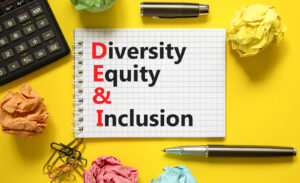
Everyone is responsible for committing to a diverse, equitable, and inclusive environment where all employees feel respected, have a sense of belonging, and can speak from their own experiences. How DEI is implemented will determine if you realize your goals.
As mentioned in Part 1, consider the bigger picture of DEI within your organization before rushing into developing a DEI training program. DEI is bigger and more strategic than any one training program. Rather than start with a company-wide training program, think bigger before you launch DEI initiatives.
- The effectiveness of DEI initiatives is dependent on an organization’s intentions. DEI programs that pay “lip service” to principles not truly valued or supported by leadership and the organization will miss the mark or fail entirely. Employees and consumers recognize when the corporate DEI stated goals don’t align with company values or principles. The most comprehensive DEI training program won’t have an impact if the organization does not value its defined DEI principles.
Whether you are creating a DEI training program, updating your policies or employee benefits, or defining company culture, consider the end in mind. “What are you ultimately trying to achieve?”
- DEI needs to be universally defined and understood across the organization. Success metrics are usually defined upfront for an effective training program. Why not take the same approach to DEI as you would before developing any HR program or learning intervention?
- Has your organization developed and communicated definitions of diversity, equity, and inclusion that everyone understands and supports?
- Have your company values, ethics, mission, and vision statements been reviewed with these DEI definitions in mind?
- What are the bigger DEI goals that underpin your corporate HR programs and processes? Have these even been identified?
- What does your DEI strategic roadmap look like? Does one exist?
- How is DEI defined differently within a global company? What “globalized” approaches must be in place to adapt DEI in different countries, cultures, and geo-political environments?
- Leadership engagement is critical in DEI initiatives. DEI is often relegated to the HR organization or Learning and Development team for championing and While DEI approaches must be managed by capable project managers and DEI Subject Matter Experts, the organization’s leadership will ultimately determine the success of DEI initiatives. Consider:
- Has senior leadership been involved in the development of DEI definitions and DEI strategy? Do they endorse it? Can they verbalize these DEI goals and definitions to others?
- Do your leaders at all levels serve as DEI role models?
- How have middle managers and first-line leaders been engaged when embedding DEI concepts into current HR programs or policies?
- If shadow boards, employee resource groups (ERGs), or affinity groups exist within the company, how have they been tapped to provide inputs for DEI strategy and prioritization?
- Recognize that leaders may be uneasy or unfamiliar with DEI concepts in general. Change can be hard or unsettling, often resulting in leadership pushback. Have a plan to anticipate and address resistance.
- How can corporate leadership be an advocate for DEI inside as well as outside the organization?
Engaging leadership is time intensive. Yet, leadership buy-in and support of your company’s DEI approach will determine if you reach your objectives.
- DEI goals need to be integrated and embedded throughout the organization. Establishing a DEI culture requires setting measurable goals, creating accountability, and integrating these into all organizational processes and programs. Before launching a DEI training program, review what is already in place that should align with your organization’s DEI strategy and goals.
- How have DEI goals been integrated into current HR processes, such as performance management, talent acquisition, onboarding, succession planning, compensation planning, coaching, mentoring, etc.?
- How have DEI goals been embedded into employee communication channels?
- What content in existing leadership and other L&D programs must be updated to align with your DEI strategy and approach?
- What approaches to equity have been built into your employee wellness and health, compensation, and other benefit programs?
- How have HR policies, such as leave, tuition reimbursement, company allowances, and employee onboarding, aligned with DEI goals? Are they applied equitably across all employees in your organization?
- How can all employees apply DEI concepts in their workday and environment? What tools have been provided to make DEI ideas easier to apply?
Creating a diverse, equitable, and inclusive workplace is an iterative process that will take time and constantly evolve. DEI training programs can be one of several elements of a broader DEI strategic corporate approach. As a first step, assess how your company is structured and how it operates before launching a DEI program. These assessment results will help you identify areas for improvement and DEI ‘blind spots’ that will take more than the best DEI training program.
Holly Young is a Partner at PeopleResults. You can reach her at hyoung@people-results.com or follow her on LinkedIn.




